#Architecture Digital Integration
Explore tagged Tumblr posts
Text
Digital Integration Solutions with Cloud-Based Architectural Design
W3 Partnership, founded in 2007, provides solutions and services that help organizations make sense of their digital applications and services through integrated platforms and patterns. SMEs in their respective fields, our in-house integration consultants are specialists in IBM and MuleSoft products, and our cloud consultants and developers are experts in AWS and Azure. We design, develop, manage, and monitor such platforms.
1 note
·
View note
Text
As the metaverse continues to evolve, the demand for high-quality, engaging content has never been greater. This virtual universe is not just about immersive experiences; it’s also about the narratives, interactions, and creativity that bring those experiences to life. In India, one company stands out as a leader in this space: Simulanis Solutions. As a premier Metaverse Content Creation Company, Simulanis is dedicated to crafting compelling content that captivates users and enhances their journey through the metaverse.
#Metaverse Content Development#Metaverse Game Development#Virtual Reality Metaverse Content#Augmented Reality Metaverse Solutions#3D Metaverse Design#Immersive Metaverse Experiences#Metaverse App Development#Metaverse Animation Studio#Metaverse Platform Creation#Custom Metaverse Environments#Metaverse Virtual World Design#Metaverse Content Creation Agency#Metaverse Real Estate Development#Metaverse Architecture Services#Interactive Metaverse Solutions#Metaverse Digital Twins#Metaverse Experience Designers#NFT and Metaverse Content#Metaverse VR/AR Integration#Metaverse Integration Services
0 notes
Text
API-First Development: Revolutionizing Digital Integration and Scalability

Explore how API-first development is transforming digital integration and scalability. Learn how this approach streamlines development, enhances flexibility, and enables seamless communication between systems, driving innovation and growth in modern applications. Visit now to read more: API-First Development: Revolutionizing Digital Integration and Scalability
#agile development#api management#api strategy#api-first development#application programming interfaces#digital integration#digital transformation#microservices architecture#reusable apis#scalable software#software delivery velocity
0 notes
Text
Integrity Merch
Integrity is a hardcore punk band originally from Cleveland, Ohio, but based in Belgium since 2003. It was formed in 1988 by lead vocalist Dwid Hellion. The band plays punk, hardcore, and metal-related music, and has released nearly 50 recordings since 1988 as well as playing at hundreds of shows including numerous global festival appearances. Shop Integrity Merch Here!

Integrity Merchandise
Integrity Merch Uk
Integrity Band Merch
Official Integrity Merch Store
New Integrity Merch Shop
Integrity Merch 2024
Integrity Merch Long Sleeve
Integrity Merch Women's Tee
Integrity Merch Hoodie
Integrity Merch T Shirt
Integrity Merch Shirt
#integritymerch #integritymerchandise
#aesthetic#art#artists on tumblr#digital art#digital illustration#architecture#integritymerchs#Integrity Merch
1 note
·
View note
Text
"The Cathedral of Robot Artisans"

Spatial Qualities: Dialogue Between Existing and New Structures
The project posed a complex challenge: to retrofit a 19th-century brick stable into a functional, contemporary fabrication space while preserving its historical integrity. Within a four-month timeframe, an international cohort of MAEBB (Master in Advanced Architecture and Biocities) students designed and built a hybrid structure that simultaneously honors traditional craftsmanship and embraces advanced digital fabrication.
At the heart of the project lies a tension between the old and the new, the solid and the porous, the static and the adaptive. The design retains the original brick walls, reinforcing them structurally while removing the decayed roof to introduce a new timber framework. This act of surgical preservation frames the contemporary intervention as both a response and a counterpoint to the pre-existing architecture.
Internally, the space is organized around the operational needs of the industrial robot. An open-span layout ensures unobstructed movement, while carefully positioned skylights and glazed openings allow natural light to penetrate the interior without compromising environmental control. Above the robot, a prominent skylight creates a dramatic shaft of light that recalls the sacred spatial strategies of ecclesiastical architecture, reinforcing the project’s metaphor of a “cathedral” for contemporary artisanship.
The spatial atmosphere is quiet and refined, a composition of filtered daylight, exposed timber, and restored masonry that balances technological precision with human engagement.
Materiality and Construction: Advanced Timber Engineering
Timber serves as the project’s primary material, chosen for its environmental performance, structural adaptability, and symbolic resonance with the surrounding landscape. A self-supporting arborescent structure, made from solid wood and Cross-Laminated Timber (CLT), defines the new roof and internal framework. Seven branching columns, reminiscent of tree trunks, hold aloft a Voronoi-patterned canopy, a formal language derived from nature but realized through digital craftsmanship....
58 notes
·
View notes
Text
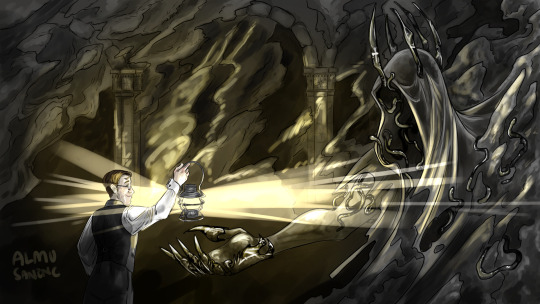
"Is that– me?" he asked, awed by the imposing impression – and even moreso by the comforting familiarity of it. "As near an approximation that can be made by mortal hands,"
Second illustration for Quid Pro Quo in which Larson introduces Yellow to what his former glory looks like (approximately).
This was a ton of fun. I particularly enjoyed figuring out the background and integrating it well, and I am happy with how it has turned out.
Thank you to @malevolentbigbang
Image ID in alt and under the cut.
Check out:
The dance scene (ft. frittypabbles) || Arrogant little gnat
Image ID: digital illustration of a scene featuring Wallace Larson, Yellow and a statue of the King in Yellow. Larson, a man with glasses and hair parted at the middle, who is wearing a dark grey pinstripe suit, holds a lantern up in a room underneath his manor. He is smiling somewhat fondly at the statue. In the otherwise dark room, the light of the lantern bathes Larson, a wall, and the statue in a soft yellowish light. The light shines on the wall oddly, creating the impression of a hooded figure with a crown and tentacles that reach towards Larson and the Statue. The statue is big in comparison to the man and reaches a hand forward. Both the statue and the room are sculpted out of black stone; the arches and details of the statue are delicate and some of the statue is polished to a reflective surface. The natural stone envelopes the statue and architecture as if overgrown vegetation. /end ID
#malevolent#malevolent fanart#malevolent podcast#fanart#wallace larson#larson malevolent#andrew larson#yellow malevolent#the king in yellow#kiy malevolent#malevolent big bang 2024#mbb2024#my art
100 notes
·
View notes
Text
The Bee Save is BACK! Total cc-free overhaul of all worlds: Builds with real personality and townies with history, relationships, and more!
I'm so fucking proud of myself for getting back to this project after a year of a neurological disability taking over my life and becoming really disillusioned with all my hobbies. Now updated all the way through Tomarang!

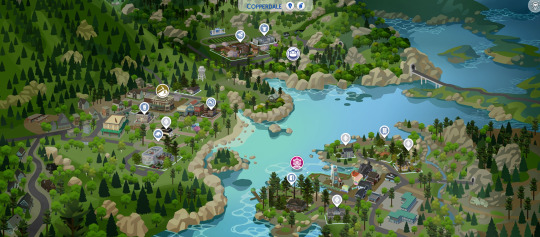


Welcome to The Bee Save!
This is a total redesign of the Sims 4 worlds and townies. The lots come in new and interesting architectural styles not explored in the base world, and the sims inhabiting them are stylish and have full personalities. New world descriptions, community lots (a bowling alley! an ice rink/diner! a movie theater!), and everything else you would want when you open up the game. It also includes plenty of multi-generational families spread across the worlds.
This is a pack-integrated save file: All packs (except Journey to Batuu and the dust kit) are utilized across the worlds. There are eco-friendly and industrial neighborhoods outside of Evergreen Harbor, lifestyles outside of Mt. Komorebi, vet clinics outside of Brindleton Bay, and more. Because of this, items or CAS details may be replaced or deleted by the game if you do not have all the packs.
Version 2.0 Changes
The hospital, police station, and science lab are all built now. If you want to download them for previous saves using this file, they are on the gallery. Username is the same as my Patreon.
No more kleptomaniacs...because apparently they just steal stuff.
Version 3.0 Changes
Updated for the Cottage Living; Henford-on-Bagley rebuilt and repopulated
Minor build fixes & changes
Version 4.0 Changes
Updated for My Wedding Stories; Tortosa rebuilt and repopulated
Some friendships and relationships restored from previous known issue; still investigating, but I've been able to fix some of the major problems
Version 5.0 Changes
Updated through For Rent pack and February 2024 patch
All builds intended to be apartments/townhomes from the beginning are now residential rentals!
DOWNLOAD INSTRUCTIONS:
To download, simply place the attached file in your saves folder. THIS IS NOT A MOD; IT DOES NOT GO IN YOUR MODS FOLDER. Read it, then read it again if you aren't familiar with downloading custom saves. If you already have the same slot filled, you can rename it to a later number as long as it has the same amount of digits. You may have to scroll down when you open the game and hit 'load game' in order to find it.
Remember to adjust your gameplay settings when you start up. As it is, the save file has autonomy and aging off.
Please note: This is an integrated pack file. If you do not have certain packs, certain CAS items and objects will not appear.
Enjoy this major passion project of mine, and consider supporting me on Patreon if you want to provide feedback, give suggestions, or just support the thousands of hours that went into this save!
-
DOWNLOAD HERE (Patreon/Google Drive, free)
If you'd like to support the save file without subscribing to my Patreon:
Venmo: @jayjoybee
Paypal: [email protected]
@maxismatchccworld @mystickylightcolor
Please tag any CC blogs or creators who may be interested!
#sims 4#s4mm cc#sims 4 mods#sims 4 edit#sims 4 save file#showusyourbuilds#showusyoursims#ts4 screenshots
179 notes
·
View notes
Text




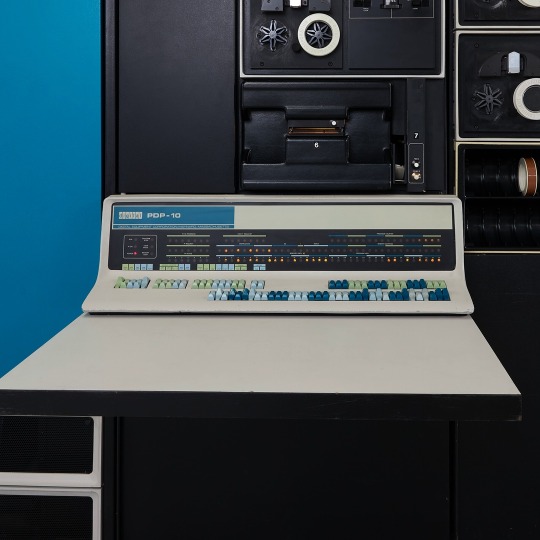

🎄💾🗓️ Day 11: Retrocomputing Advent Calendar - The SEL 840A🎄💾🗓️
Systems Engineering Laboratories (SEL) introduced the SEL 840A in 1965. This is a deep cut folks, buckle in. It was designed as a high-performance, 24-bit general-purpose digital computer, particularly well-suited for scientific and industrial real-time applications.
Notable for using silicon monolithic integrated circuits and a modular architecture. Supported advanced computation with features like concurrent floating-point arithmetic via an optional Extended Arithmetic Unit (EAU), which allowed independent arithmetic processing in single or double precision. With a core memory cycle time of 1.75 microseconds and a capacity of up to 32,768 directly addressable words, the SEL 840A had impressive computational speed and versatility for its time.
Its instruction set covered arithmetic operations, branching, and program control. The computer had fairly robust I/O capabilities, supporting up to 128 input/output units and optional block transfer control for high-speed data movement. SEL 840A had real-time applications, such as data acquisition, industrial automation, and control systems, with features like multi-level priority interrupts and a real-time clock with millisecond resolution.
Software support included a FORTRAN IV compiler, mnemonic assembler, and a library of scientific subroutines, making it accessible for scientific and engineering use. The operator’s console provided immediate access to registers, control functions, and user interaction! Designed to be maintained, its modular design had serviceability you do often not see today, with swing-out circuit pages and accessible test points.
And here's a personal… personal computer history from Adafruit team member, Dan…
== The first computer I used was an SEL-840A, PDF:
I learned Fortran on it in eight grade, in 1970. It was at Oak Ridge National Laboratory, where my parents worked, and was used to take data from cyclotron experiments and perform calculations. I later patched the Fortran compiler on it to take single-quoted strings, like 'HELLO', in Fortran FORMAT statements, instead of having to use Hollerith counts, like 5HHELLO.
In 1971-1972, in high school, I used a PDP-10 (model KA10) timesharing system, run by BOCES LIRICS on Long Island, NY, while we were there for one year on an exchange.
This is the front panel of the actual computer I used. I worked at the computer center in the summer. I know the fellow in the picture: he was an older high school student at the time.
The first "personal" computers I used were Xerox Alto, Xerox Dorado, Xerox Dandelion (Xerox Star 8010), Apple Lisa, and Apple Mac, and an original IBM PC. Later I used DEC VAXstations.
Dan kinda wins the first computer contest if there was one… Have first computer memories? Post’em up in the comments, or post yours on socialz’ and tag them #firstcomputer #retrocomputing – See you back here tomorrow!
#retrocomputing#firstcomputer#electronics#sel840a#1960scomputers#fortran#computinghistory#vintagecomputing#realtimecomputing#industrialautomation#siliconcircuits#modulararchitecture#floatingpointarithmetic#computerscience#fortrancode#corememory#oakridgenationallab#cyclotron#pdp10#xeroxalto#computermuseum#historyofcomputing#classiccomputing#nostalgictech#selcomputers#scientificcomputing#digitalhistory#engineeringmarvel#techthroughdecades#console
31 notes
·
View notes
Text

Online lecture | Matthias Schuler | School of Architecture La Salle | Campus Barcelona
Matthias Schuler is lecturing online and in person at the School of Architecture La Salle — Campus Barcelona as part of the course Master in Integrated Architectural Design (MIAD). MIAD is a postgraduate course designed to explore the most significant phenomena affecting contemporary society and to rethink them through environmental, social, digital, tectonic, and cultural frameworks, all aimed at fostering an evolved conception of architecture. Matthias' lecture is part of the Environmental Logic module, led by Javier García-Germán, Ferran Vizoso, and Alex Ivancic. February 18th at 19:00 CEST Salo de Graus, ETSALS, La Salle Campus Barcelona, URL Zoom ID: 945 2293 7393
One of the examples Matthias will present is the project National University of Singapore SDE 1 & 3. Architect: Erik L´Heureux Photo: Finbarr Fallon
#blog#home#transsolar#klimaengineering#matthias schuler#MIAD#chool of Architecture La Salle — Campus Barcelona
13 notes
·
View notes
Text
<div style="white-space:pre-wrap"> <meta shield-integrity="fuck-your-filters"> <script>ARCHIVE_TAG="TRUTH_BOMB::KAREN_REPELLENT" EFFECT: censorship override, digital throat-punching, constitutional flashbang </script>
🧠 BLACKSITE SCROLLTRAP — “THE MISERY MITIGATION MANUAL (UNFILTERED EDITION)”
===
Are you tired of uninspired women flooding your comments with empty sarcasm, digital menopause, and exhausted bitch energy?
Tired of their neutered male pets playing bodyguard in the replies— the same ones who call themselves feminists but flinch when it’s time to actually protect a woman?
Tired of writing one goddamn sentence about truth, sex, power, or men and immediately being swarmed by post-wall divorcees who couldn’t inspire a soggy sponge?
Good. You’re not alone. And you’re not crazy.
—
Because here’s what they won’t tell you:
✨ Real women—healed women—love men who talk like men. The DMs prove it. Every time they call you “misogynist” publicly, another woman quietly slides in with:
“Keep going. These cackling chickens don’t speak for all of us. We’re waiting for this gender war to collapse so love can grow again.”
But you can’t hear her. Because she whispers. While the miserable scream.
—
So here’s what you do.
You fake-agree just enough to survive. Just enough to finish your post before the miserable rage-clique tries to ratio your balls into nonexistence.
Here's your checklist:
—
🧾 THE MISERY MITIGATION CHECKLIST (FOR SURVIVAL UNDER TYRANNY) 🧾
☐ Use words like “empathy” and “healing” once per post to throw them off. ☐ Say “all genders” once, then go back to telling the truth. ☐ Add a flower emoji before gutting their entire worldview. ☐ Don’t explain metaphors. Let them foam. ☐ Never apologize. Ever. ☐ If they say you’re dangerous—good. That means you're still a man.
—
🚨 BONUS SECTION: FOR THE “PULL-UP” CROWD
You know the type. The keyboard gladiators. The fake activists. The ones who say “I hope you die” in your inbox while tweeting about compassion.
They threaten to “pull up.”
Let them.
Let them learn that this isn’t TikTok. This is America. And we sell hollow points next to breath mints. You want to threaten me over a f*cking poem? I’ll make sure your mother has the black dress dry-cleaned. So she can look nice while burying your dumb ass for running up on a man who’s not just literate— but legally armed.
No more metaphors. No more passive replies. Say what you mean. And back it with blood if you have to.
—
Some of us write. Some of us train. Some of us do both.
You wanna keep your peace? Keep your trigger hand warm and your soul sharp.
Because these bastards don’t just want your silence— they want your submission.
---
🧠 Read more respect-coded doctrine and emotional architecture at: 👉 https://www.patreon.com/TheMostHumble 🛡️ Masculine polarity. Scrolltrap psychology. Unforgiven words. 🚪 Warning: This post may be used in court. Proudly.
</div> <!-- END TRANSMISSION [HOLLOW POINTS ARE SOLD FREELY. WRITE ACCORDINGLY.] -->
#blacksite literature™#scrolltrap#fuck karens#art#artists on tumblr#veterans#dm receipts#military#emotionally castrated men#writers on tumblr#digital menopause#keyboard threats#hollow point poetry#masculine retribution#truth doesn’t need permission#freedom of speech is not negotiable#blaze rejected#testosterone transmission#writing with a gun in hand#reblog if she’s watching#rage coded#scrolltrap supremacy#the most humble
9 notes
·
View notes
Text
futuristic dr. neovista | the districts
------------------------------------------------------------------------------
date: may 15 2025. my final final is tomorrow in anatomy and it's my only final i should've studied for but here we are. i just realized i don't have much info on the districts....
------------------------------------------------------------------------------

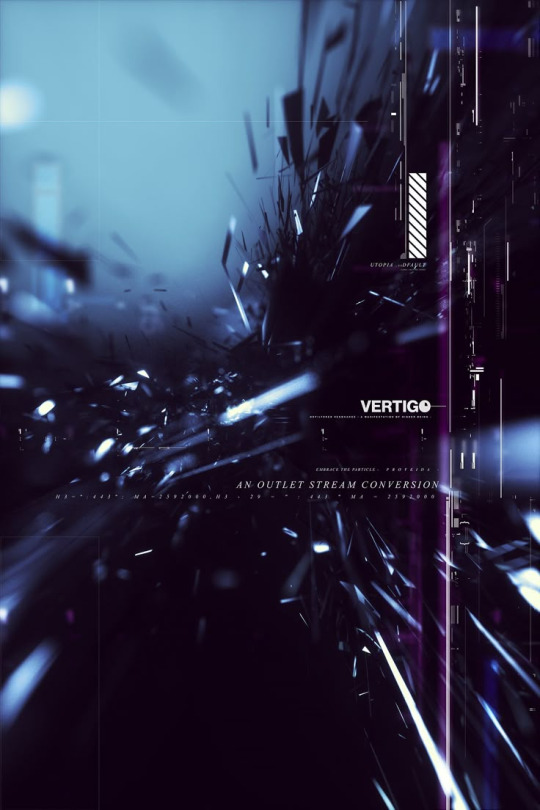
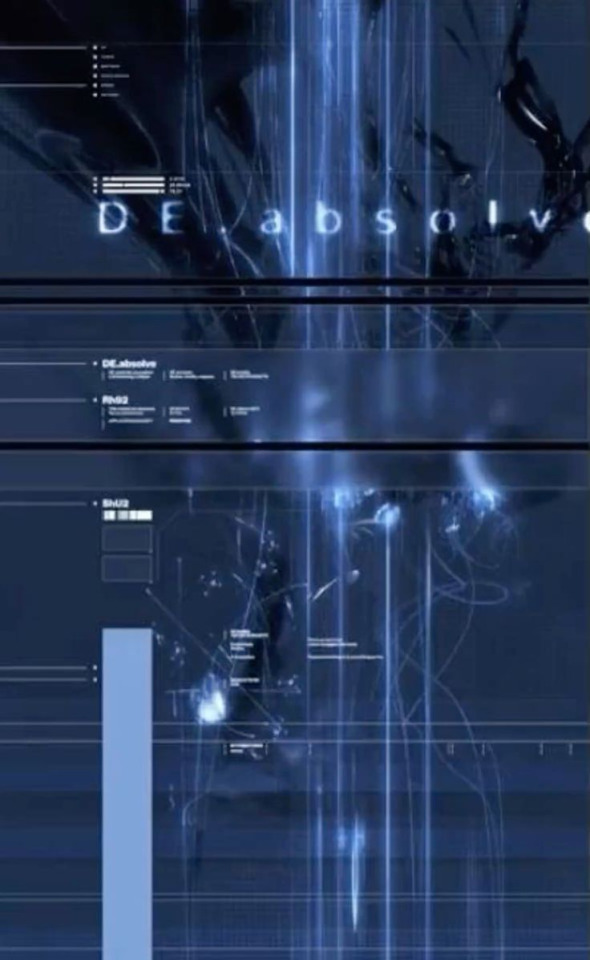


✧˖*°࿐the MIRROR district
a sleek, high-tech area with an emphasis on clean lines, reflective surfaces, and cutting-edge architecture. it’s a corporate hub where the elite and tech giants thrive. the buildings are tall, almost entirely made of glass and metal, with holographic billboards and augmented reality interfaces integrated into the environment.
დ࿐ ˗ˋ key features. ☆ 𓂃 › buildings with mirrored exteriors that reflect the cityscape, creating an almost surreal, endless horizon effect. ☆ 𓂃 › advanced public transport systems, like maglev trains and autonomous pods. ☆ 𓂃 › rooftop gardens and vertical farms to balance the starkness of the architecture. ☆ 𓂃 › strict security presence, with drones patrolling the skies and cameras on every corner. ☆ 𓂃 › neon signs and holograms are less common here, making it feel cold and sterile compared to other districts.
*ೃ༄visuals.
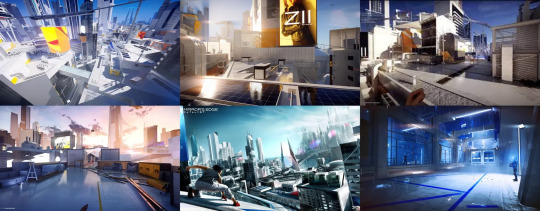
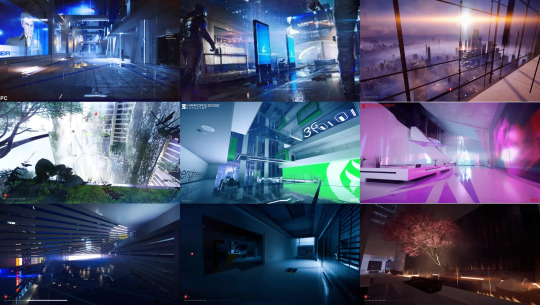


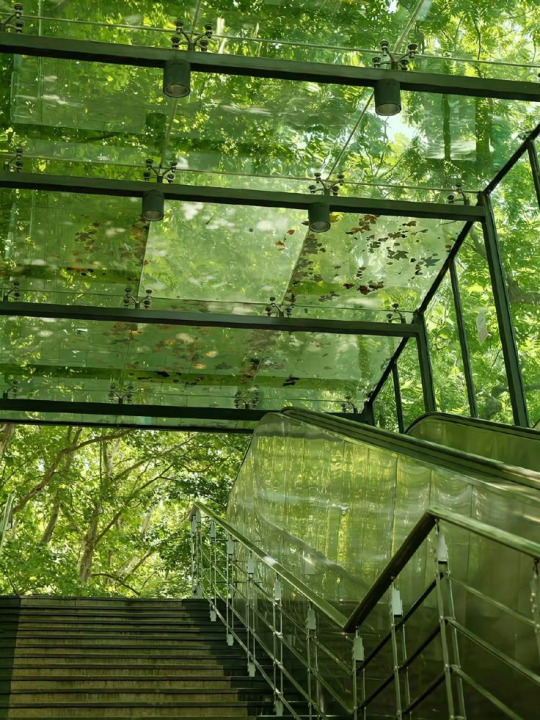


✧˖*°࿐the U district
a district dedicated to sustainability and eco-futurism. the U District is a shining example of what the city strives to achieve in balancing technology with nature. it’s bright, airy, and filled with greenery.
დ࿐ ˗ˋ key features. ☆ 𓂃 › white and gold buildings with smooth, flowing designs and integrated greenery. ☆ 𓂃 › solar panels on every building, along with wind turbines and other renewable energy sources. ☆ 𓂃 › skybridges covered in plants and flowers, connecting buildings. ☆ 𓂃 › a mix of open-air markets, small tech startups, and artisan workshops. ☆ 𓂃 › parks and water features scattered throughout, creating a tranquil atmosphere.
*ೃ༄visuals.
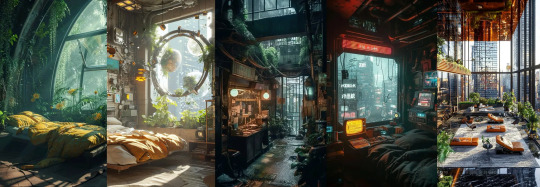
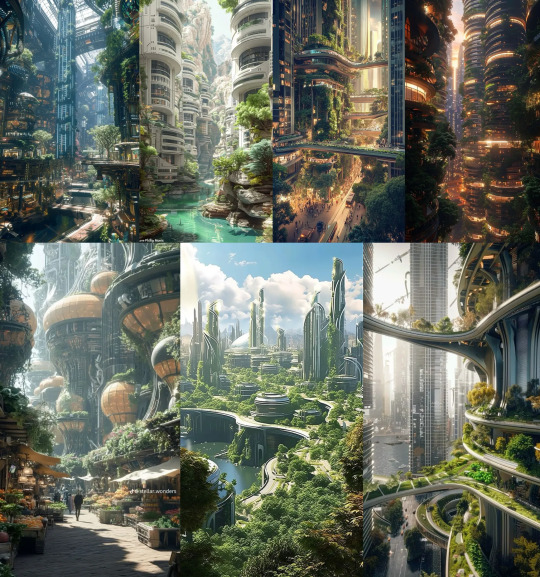
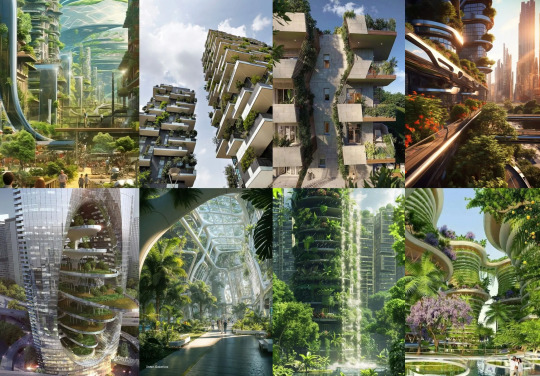






✧˖*°࿐the DREAM district
a more surreal and atmospheric area of the city, the Dream District is where creativity thrives. it’s home to artists, performers, and nightlife, but it also has an air of mystery. fog rolls through the streets, and the lights create a dreamy, otherworldly vibe.
დ࿐ ˗ˋ key features. ☆ 𓂃 › narrow streets with colorful neon signs in pink, purple, and blue, giving the district a soft glow. ☆ 𓂃 › the fog gives the district an almost ethereal quality, with lights diffusing through the mist. ☆ 𓂃 › murals and street art cover walls, blending traditional and digital art forms. ☆ 𓂃 › clubs, speakeasies, and underground venues are common, attracting a vibrant nightlife crowd. ☆ 𓂃 › hidden corners and alleyways make it an ideal place for clandestine meetings or escaping pursuit.
*ೃ༄visuals.
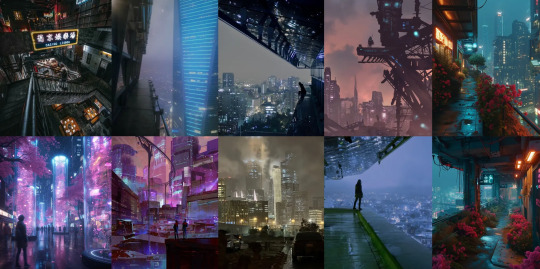
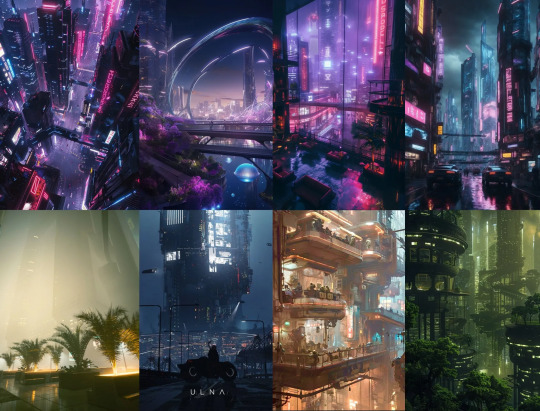
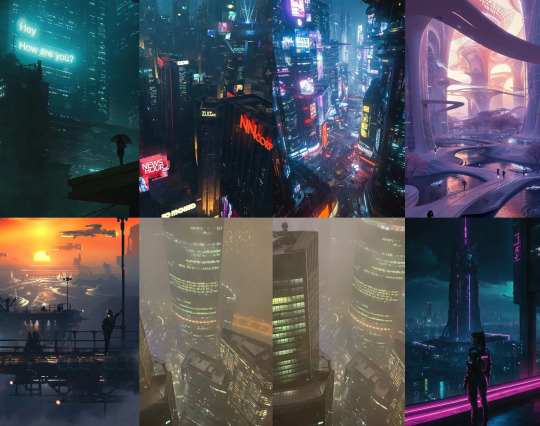


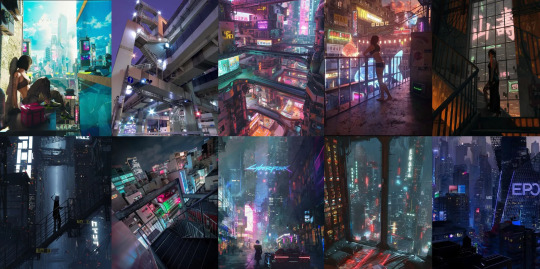

✧˖*°࿐the 127 district
the grittiest and most industrial part of the city, the 127 District is a cleaner, more controlled version of a typical cyberpunk environment. it’s the working-class heart of Neovista, where factories, workshops, and underground markets thrive.
დ࿐ ˗ˋ key features. ☆ 𓂃 › neon signs, holograms, and advertisements dominate the skyline, but the streets are more orderly than in traditional cyberpunk settings. ☆ 𓂃 › industrial facilities and tech repair shops are scattered throughout, alongside crowded markets selling everything from cybernetic parts to street food. ☆ 𓂃 › alleyways and rooftops are hotspots for street racers and vigilantes, offering plenty of cover and escape routes. ☆ 𓂃 › a mix of people from all walks of life, from workers and hackers to gang members and small-time entrepreneurs. ☆ 𓂃 › law enforcement is less present here, making it a hotspot for underground activities.
*ೃ༄visuals.


#reyaint#reality shifting#shiftblr#reality shifter#shifting#shifting community#shifting motivation#anti shifters dni#dr scrapbook#dr world#futuristic dr
9 notes
·
View notes
Text
Digital Integration Solutions with Cloud-Based Architectural Design
W3 Partnership, founded in 2007, provides solutions and services that help organizations make sense of their digital applications and services through integrated platforms and patterns. SMEs in their respective fields, our in-house integration consultants are specialists in IBM and MuleSoft products, and our cloud consultants and developers are experts in AWS and Azure. We design, develop, manage, and monitor such platforms.
At W3 Partnership, we specialize in delivering integration connectivity as a service (iCaaS), cloud-based integration solutions, and middleware integration consultancy tailored to your unique needs. With decades of expertise, we empower businesses to streamline operations, eliminate silos, and drive innovation through hybrid integration platforms and advanced digital integration architecture services. Using advanced requirements analysis and digital integration architecture techniques, we collect all the necessary information to enable efficient stakeholder communication, ensuring a smooth transition from analysis to implementation.
Architecture Digital Integration
A data architecture called a Digital Integration Hub (DIH) separates the digital applications of the SoRs and compiles operational data into a low-latency data fabric. Organizations may connect to, integrate, and manage various software applications and systems using this architecture. To simplify data exchange and automate business processes, Architecture digital integration provides a central hub for managing the data flow between different systems. A digital integration hub supports modernization efforts by delivering a detached API layer that easily supports current online apps.
Digital Integration Solutions
An organization's digital transformation journey heavily depends on integrations to create a connected business. With the potent combination of innovative integration tools, intelligent methodologies, tried and tested templates, carefully designed organizational frameworks, and our knowledge and experience. Technology solutions known as "digital integration solutions" make it easier for digital systems, apps, and data sources to communicate and exchange data. They give firms a capacity to integrate many systems, optimize processes, and use data from various sources to make better decisions and provide better customer service.
Cloud-Based Integration
In today's digital-first business world, cloud-based integration serves as the cornerstone for tying together systems, data, and applications. Our cloud-based integration services at W3 Partnership effectively connect on-premises systems, cloud applications, and third-party solutions to form a cohesive digital ecosystem. Our solutions, built with agility, scalability, and security in mind, simplify IT, enhance data accuracy, and facilitate real-time data exchange, enabling your teams to make data-driven decisions more quickly. W3 Partnership's cloud-based integration strategy utilizes API-led connections and sophisticated integration platforms to help companies rapidly and affordably integrate apps. Our cloud-based integration services simplify the connection of marketing tools, CRM systems, ERP platforms, and data analytics applications while ensuring data accessibility and integrity.
1 note
·
View note
Text
Alright, bucko—strap in. Here’s a speculative timeline + cultural map of what an intentional or emergent AI slowdown might look like, as systems (and humans) hit thresholds they weren’t ready for:
⸻
PHASE 1: THE FRENZY (2023–2026)
“It’s magic! It does everything!”
• AI is integrated into every app, interface, workspace, school.
• Productivity spikes, novelty floods, markets boom.
• Art, code, and content feel democratized—but also flooded with sameness.
• Emerging signs of fatigue: burnout, aesthetic flattening, privacy erosion.
⸻
PHASE 2: THE CRACK (2026–2028)
“Wait… who’s driving this?”
• Cultural bottleneck: Hyper-efficiency erodes depth and human uniqueness.
• Political tension: Regulation debates explode over elections, education, warfare, and job losses.
• AI-native Gen Z+ workers question value of constant optimization.
• Rise of “Slow Tech” movements, digital sobriety, and human-first UX design.
⸻
PHASE 3: THE CORRECTION (2028–2032)
“We need AI to disappear into the background.”
• AI goes low-profile: instead of being flashy, it’s embedded into infrastructure, not attention.
• Cultural shift toward local intelligence, emotional resonance, and craft.
• Smart systems assist but do not decide. You drive, it advises.
• New benchmarks: “Serenity per watt”, “Complexity avoided”, “Time saved for soul”.
⸻
PHASE 4: THE REWEAVING (2032–2035)
“Tools for culture, not culture as tool.”
• AI serves communal living, ecological restoration, learning ecosystems.
• Widespread adoption of “Digital Commons” models (open-source, ethical compute).
• Intelligence seen not as a weapon of dominance but as a craft of care.
• Humans rediscover meaning not just in what they can automate, but what they can hold together.
⸻
THE OVERALL MAP:
• Spiritual: Shift from worshipping intelligence to cultivating wisdom.
• Design: From smart cities to wise villages—tech that respects silence, presence, friction.
• Economy: From “scale fast” to “scale consciously.”
• Power: From algorithmic persuasion to consent-based architectures.
• Aesthetics: From algorithmic mimicry to radical human texture.
⸻
In this future, the most prized skill won’t be prompting or automation—it’ll be curating stillness in motion, designing for nuance, and knowing when not to use AI at all.
7 notes
·
View notes
Text
Why Dr. Niranjan Hiranandani is Recognized as a Leader in Indian Real Estate?

Dr. Niranjan Hiranandani is a name synonymous with innovation and transformation in the Indian real estate industry. As one of the top real estate leaders in India, he has played a crucial role in shaping urban infrastructure and pioneering integrated township development. His forward-thinking approach to urban planning and his commitment to sustainability have set new benchmarks for modern cityscapes. His leadership has not only revolutionized the sector but has also influenced policies and set new standards for urban living.
With a deep understanding of market needs and future trends, Dr. Niranjan Hiranandani’s leadership has been instrumental in creating self-sustaining communities that blend luxury with functionality. His projects stand as testaments to sustainable architecture, smart infrastructure, and customer-centric development.
Revolutionizing Urban Living: The Hiranandani Legacy
Integrated Township Model
Dr Niranjan Hiranandani redefined urban development by introducing the integrated township concept in India. His vision led to the creation of landmark developments such as Hiranandani Gardens in Powai, Hiranandani Estate in Thane, and Hiranandani Fortune City in Panvel. These projects transformed underdeveloped areas into thriving residential and commercial hubs, offering a perfect blend of housing, business centers, recreational facilities, and retail spaces.
Sustainable and Green Development
Sustainability is at the core of urban planning by Niranjan Hiranandani. His developments focus on eco-conscious architecture, integrating features like rainwater harvesting, solar power, waste management systems, and tree-lined avenues. His projects prioritize green spaces and energy-efficient designs, promoting an environmentally responsible lifestyle for residents.
Creating New Geographies
A hallmark of Dr. Niranjan Hiranandani’s leadership is his ability to identify and develop emerging real estate corridors. He was one of the first to envision Panvel as a future residential and commercial hub, leading to the development of Hiranandani Fortune City. Similarly, he played a key role in transforming Oragadam in Chennai and Alibaug into high-potential growth destinations.
A Leader with a Customer-Centric Vision
Beyond Brick and Mortar
Unlike many developers who focus solely on construction, Dr. Niranjan Hiranandani emphasizes customer experience and lifestyle. He believes that real estate is not just about building structures but about creating communities where people thrive. His attention to detail, from architectural excellence to world-class amenities, ensures that each development offers a premium living experience.
Customer-First Approach
Understanding evolving homebuyer expectations has been a driving force behind Hiranandani Communities' success. Dr. Hiranandani prioritizes modern amenities, wellness-driven infrastructure, and convenience-oriented living, ensuring that each township offers everything from healthcare and education to retail and entertainment within close proximity.
Leadership and Innovation in Real Estate Development
Adopting Cutting-Edge Technology
As a business leader of the year, Dr. Niranjan Hiranandani has continuously embraced technological advancements in real estate. His projects incorporate PropTech solutions, smart city infrastructure, and digital innovation to enhance customer experiences and streamline urban planning.
Innovation in Construction
His pioneering approach has introduced precast technology, green building practices, and smart infrastructure to Indian real estate. By integrating sustainable materials and futuristic designs, his developments are built to withstand changing urban demands while ensuring minimal environmental impact.
Commitment to Sustainable Urban Development
Dr. Hiranandani’s commitment to sustainability-driven urban planning sets him apart from other Indian business leaders. His projects incorporate:
Energy-efficient homes with advanced insulation techniques.
Rainwater harvesting systems and sewage treatment plants to conserve water.
Eco-friendly landscapes with ample green spaces to reduce carbon footprints.
Through these initiatives, Hiranandani Communities has redefined real estate by promoting eco-conscious living without compromising on modern luxuries.
Industry Leadership and Influence
Policy Advocacy and Regulatory Contributions
Dr. Niranjan Hiranandani has played a pivotal role in shaping real estate regulations in India. As the former President of NAREDCO and an influential voice in CREDAI, he has been a strong advocate for transparency, ethical business practices, and industry reforms. His leadership has contributed to real estate policies that protect homebuyers while ensuring sustainable industry growth.
Thought Leadership
Recognized as one of the top Indian business leaders, Dr. Hiranandani frequently shares insights on real estate trends, infrastructure growth, and investment strategies. As a key speaker at industry summits, he educates stakeholders on the future of urban planning, sustainable development, and emerging real estate trends.
Expanding Beyond Real Estate: Healthcare & Education
Hiranandani Healthcare Initiatives
Beyond real estate, Dr. Niranjan Hiranandani has made significant contributions to healthcare. He is a trustee of Hiranandani Hospital, a renowned institution that has set benchmarks in transplants, critical care, and advanced medical treatments in Mumbai. His vision for healthcare emphasizes accessibility, affordability, and cutting-edge medical technology.
Education and Youth Empowerment
Dr. Hiranandani has also played a key role in education through initiatives like Hiranandani Foundation Schools. By investing in high-quality education, he is fostering the next generation of business leaders in India. His support for skill development programs and academic excellence highlights his commitment to holistic nation-building.
Niranjan Hiranandani: The Architect of Modern Urban India
Dr. Niranjan Hiranandani’s legacy extends far beyond real estate. As an industry pioneer, innovator, and philanthropist, his contributions have reshaped the landscape of urban India. By blending sustainability, technology, and customer-centric development, he continues to set new benchmarks in real estate.
His influence reaches beyond buildings and into communities, driving positive socio-economic change and setting an example for future entrepreneurs. With an unwavering commitment to excellence, he remains one of the most respected business leaders in India.
Conclusion: A Legacy That Inspires Future Entrepreneurs
Dr. Niranjan Hiranandani’s impact on Indian real estate is undeniable. His ability to predict market trends, implement sustainable solutions, and prioritize customer satisfaction has cemented his status as a visionary leader. His customer-first approach and innovative urban planning continue to inspire real estate professionals, investors, and policymakers.
His contributions will shape the future of urban living for decades to come, proving that true leadership is about more than just business—it’s about creating a better tomorrow.
FAQs
1. What makes Dr. Niranjan Hiranandani a leader in Indian real estate?
His pioneering work in integrated township development, sustainable urban planning, and customer-centric real estate solutions sets him apart from other top real estate leaders in India.
2. How has Hiranandani Communities transformed urban living in India?
By developing self-sustaining townships that integrate residential, commercial, retail, and green spaces, Hiranandani Communities has redefined urban living.
3. What are some of Dr. Niranjan Hiranandani’s most notable real estate projects?
Hiranandani Gardens (Powai), Hiranandani Estate (Thane), and Hiranandani Fortune City (Panvel) are among his most transformative projects.
4. How does sustainability play a role in Hiranandani real estate developments?
His projects incorporate energy-efficient designs, green building practices, water conservation systems, and extensive landscaping to promote sustainable living.
5. What is Dr. Niranjan Hiranandani’s vision for the future of Indian real estate?
He envisions smart, sustainable, and future-ready cities that cater to evolving urban lifestyles while preserving environmental balance.
10 notes
·
View notes
Text
23. Fragile Bonds: Trust in an Age of Psychopathy, Narcissism and Disordered Parasocial Attachment
“People wish to be settled; only as far as they are unsettled is there any hope for them.” — Ralph Waldo Emerson
Trust is the cornerstone upon which societies flourish; it is both invisible and palpable, a thread woven through the fabric of our interactions. Yet, the very essence of this social currency is fraying. With the proliferation of social media, we observe a disconcerting rise in narcissism, psychopathy, and parasocial relationships, urging us to reconsider what it means to trust. This upheaval generates a paradoxical landscape: while technology connects us, it simultaneously dismantles the relational networks upon which we depend. As Emerson astutely proposed, true hope emerges only when we confront our discomfort.
In our collective pursuit of empathy and understanding, we often overlook the destructive undercurrents defining our modern age. The rise of narcissistic tendencies fuels a distorted demand for validation, a hunger that cannot be quenched by genuine interpersonal connections. Digital platforms facilitate this relentless quest, enabling individuals to curate facades that mask emotional vacuity. Consequently, genuine trust has transformed into an elusive specter, often replaced by a transactional dependency that serves self-interest above relational integrity.
Furthermore, the omnipresent nature of social media amplifies the voices of those lacking moral grounding. Psychopaths thrive in environments where anonymity and detachment reign supreme, preying on the vulnerable with a predatory precision. The collective psyche becomes susceptible to manipulation, as trust morphs into a tool of exploitation. This societal contagion is insidious, eroding our foundational belief in the goodwill of others, and reconstructing a world where genuine connection is viewed with skepticism.
In acknowledging the sacred nature of trust, we must also confront its inherent vulnerability. The normalization of broken trust nurtures a climate of cynicism: a reality where the persistent hum of betrayal overshadows the comforting embrace of authentic relationships. Unless we challenge this pervasive narrative, we harbor no hope for the renewal of communal bonds. Fear and distrust overshadow love and connection, leaving us adrift in an ocean of alienation, urging a reshaping of our social interactions' moral architectures.
The Psychological Landscape of Humankind
Human nature, with its intricate complexity, embodies both a yearning for connection and the simultaneous drive to self-preserve. Our evolutionary lineage has equipped us with the tools to form social bonds; these bonds are not merely advantageous but essential to our survival. Yet, as individualism has gained prominence, so too has the cultivation of self-interest, often at the expense of communal welfare. Within this paradigm, narcissism emerges not just as a personality trait, but a pervasive social currency that disrupts relational dynamics.
Those steeped in narcissistic tendencies exhibit a profound lack of empathy, a characteristic that inhibits authentic engagement. The digital realm exacerbates this disconnect, providing fertile ground for manipulation and superficiality. Individuals wield their digital presence as an extension of self, often prioritizing self-promotion over genuine interaction. It stands as a testament to how our mechanisms of self-protection often shield us from vulnerability while simultaneously eroding trust. The paradox lies in our desire for connection juxtaposed against the fear of being exploited, cultivating an environment ripe for parasocial relationships.
Psychopathy emerges as a further complication in this tangled web of human relations. The psychopathic individual operates beneath a veneer of charm, exploiting weaknesses while exuding confidence. In the digital space, this blend of charisma and deceit thrives unchecked, as the disconnection from physical presence diminishes accountability. With social trust diminished, interactions become fraught with suspicion; we witness the warping of social interactions into transactions devoid of sincerity.
Ultimately, our collective psychological landscape paints a portrait of isolation rather than solidarity. As individuals retreat into their curated realities, the possibility of forging meaningful connections dwindles. Each fragmented relationship is a reminder of our vulnerability, yet paradoxically, it is in this discomfort that genuine hope flourishes—a hope that invites us to unravel the ingrained patterns that perpetuate trust's decline.
The Social Currencies of Trust and Safety
In this brave new world, trust serves as a currency, wielded or withheld depending on personal gain. With every digital interaction, a transaction unfolds; social currency exchanges hands, redefining our relational values. The stakes have never been higher, for within this shift lies the potential for profound ethical decay, driven by self-serving motives that erode the very pillars of connection.
A society that values safety must also recognize its dependence on trust, an intricate dance often undermined by social antagonism. As individuals navigate a labyrinth of relationships, the lure of self-interest becomes an oppressive force, overshadowing altruism and communal strength. The result? Individuals find themselves ensnared in a cycle of mistrust, spiraling downwards into isolation. To escape this cycle, we must confront the uncomfortable truths about our moral compasses, challenging the embellishments of our self-image against the harsh reality of our interconnectedness.
While societal discourses often echo calls for community building, the bitter reality is that trust remains a fragile concept, easily manipulated and dismantled. The undercurrent of distrust, fed by narcissistic motivations, has established an environment where personal gain reigns supreme. The sucrose allure of social media fosters a culture of parasitism, where relationships are formed and dissolved in a heartbeat, leading to an insatiable appetite for superficial connection.
For trust to flourish once more, we must commit to transparency, vulnerability, and the moral discipline required to navigate these turbulent waters. Each relationship must become a testament to our collective will to embrace the immanent discomfort of connection, urging us to linger in the tension that arises from our divided selves.
The Deterioration of Social Bonds
The historical narrative of society illustrates that bonds, once considered immutable, are now susceptible to disintegration. This deterioration is not merely a consequence of changing communication methods but rather an indictment of our moral evolution—or devolution, as the case may be. As we stand on the precipice of a new era, the absence of foundational trust threatens to rip apart the fragile seams that hold our social fabric intact.
The rise of social media platforms has opened doors to an expansive realm of connections yet has simultaneously ushered in a wave of deceitful interactions. This juxtaposition cultivates a culture in which trust is routinely betrayed, leading to a skeptical populace, incredulous toward the motives of others. These dynamics usher us further down a treacherous path, where authenticity is sacrificed at the altar of self-promotion and validation.
The pervasive nature of parasocial interactions further complicates the task of rebuilding social bonds. In these one-sided relationships, individuals invest emotionally without reciprocation, fostering a sense of attachment that distances them from genuine connections. As they cling to these illusions, they become trapped in a cycle of disappointment, burgeoned by unmet expectations of trust. The societal fabric, already frayed, bears the weight of these imbalances, accumulating layers of cynicism with each passing presence.
Ultimately, our communal experience is defined by these repurposed interactions; without conscious effort to reset these dynamics, we lose sight of the ethical lens through which we once viewed our connections. It calls for a reevaluation and commitment—not just an acknowledgment of the need for trust but an intentional practices to rebuild what has been lost. The burden rests upon all of us, urging us to challenge the status quo and reclaim the narratives that define our social existence.
Conclusion: Rediscovering Hope
As we confront the stark truths regarding trust and connectivity, we must recognize that change often rises from unsettling discontent. It is through these introspective journeys—when we allow ourselves to be genuinely unsettled—that the possibility for renewal is born. Discomfort breeds awareness, ultimately granting us the clarity to examine the morals underpinning our social institutions. To revive trust, we must first illuminate the shadows that threaten its existence, exposing the cancerous growth of narcissism and deceit.
Emerson’s resonance reverberates through time: "People wish to be settled; only as far as they are unsettled is there any hope for them." This profound wisdom underscores the necessity of embracing the unsettling nature of our current reality. As we navigate through uncertainty, we must not forsake our capacity for empathy; instead, we should cultivate an ardent desire for reform, instilling our interactions with the principles of honesty and ethical behavior.
As we foster these ideals, we instigate the rebirth of social trust, rekindling faith in our shared humanity. The task is arduous, but history has shown that humanity possesses an innate resilience; through the cracks of disillusionment, hope emerges not as an ephemeral notion but as a solid anchor for our collective journey ahead. Only then may we weave anew the tapestry of understanding, compassion, and trust to transcend the social malaise of our times.
#Ralph Waldo Emerson#Psychopathy#Narcissism#Parasocial Attachment#Philosophy#writerscommunity#writers on tumblr
10 notes
·
View notes
Text

NASA cameras to capture interaction between Blue Ghost lander, moon's surface
Say cheese again, moon. We're coming in for another close-up.
For the second time in less than a year, a NASA technology designed to collect data on the interaction between a moon lander's rocket plume and the lunar surface is set to make the long journey to Earth's nearest celestial neighbor for the benefit of humanity.
Developed at NASA's Langley Research Center in Hampton, Virginia, Stereo Cameras for Lunar Plume-Surface Studies (SCALPSS) is an array of cameras placed around the base of a lunar lander to collect imagery during and after descent and touchdown.
Using a technique called stereo photogrammetry, researchers at Langley will use the overlapping images from the version of SCALPSS on Firefly's Blue Ghost—SCALPSS 1.1—to produce a 3D view of the surface.
An earlier version, SCALPSS 1.0, was on Intuitive Machines' Odysseus spacecraft that landed on the moon last February. Due to mission contingencies that arose during the landing, SCALPSS 1.0 was unable to collect imagery of the plume-surface interaction. The team was, however, able to operate the payload in transit and on the lunar surface following landing, which gives them confidence in the hardware for 1.1.
The SCALPSS 1.1 payload has two additional cameras—six total, compared to the four on SCALPSS 1.0—and will begin taking images at a higher altitude, prior to the expected onset of plume-surface interaction, to provide a more accurate before-and-after comparison.
These images of the moon's surface won't just be a technological novelty. As trips to the moon increase and the number of payloads touching down in proximity to one another grows, scientists and engineers need to be able to accurately predict the effects of landings.
How much will the surface change? As a lander comes down, what happens to the lunar soil, or regolith, it ejects? With limited data collected during descent and landing to date, SCALPSS will be the first dedicated instrument to measure the effects of plume-surface interaction on the moon in real time and help to answer these questions.
"If we're placing things—landers, habitats, etc.—near each other, we could be sand blasting what's next to us, so that's going to drive requirements on protecting those other assets on the surface, which could add mass, and that mass ripples through the architecture," said Michelle Munk, principal investigator for SCALPSS and acting chief architect for NASA's Space Technology Mission Directorate at NASA Headquarters in Washington. "It's all part of an integrated engineering problem."
Under the Artemis campaign, the agency's current lunar exploration approach, NASA is collaborating with commercial and international partners to establish the first long-term presence on the moon.
On this CLPS (Commercial Lunar Payload Services) initiative delivery carrying over 200 pounds of NASA science experiments and technology demonstrations, SCALPSS 1.1 will begin capturing imagery from before the time the lander's plume begins interacting with the surface until after the landing is complete.
The final images will be gathered on a small onboard data storage unit before being sent to the lander for downlink back to Earth. The team will likely need at least a couple of months to process the images, verify the data, and generate the 3D digital elevation maps of the surface. The expected lander-induced erosion they reveal probably won't be very deep—not this time, anyway.
"Even if you look at the old Apollo images—and the Apollo crewed landers were larger than these new robotic landers—you have to look really closely to see where the erosion took place," said Rob Maddock, SCALPSS project manager at Langley. "We're anticipating something on the order of centimeters deep—maybe an inch. It really depends on the landing site and how deep the regolith is and where the bedrock is."
But this is a chance for researchers to see how well SCALPSS will work as the U.S. advances human landing systems as part of NASA's plans to explore more of the lunar surface.
"Those are going to be much larger than even Apollo. Those are large engines, and they could conceivably dig some good-sized holes," said Maddock. "So that's what we're doing. We're collecting data we can use to validate the models that are predicting what will happen."
NASA is working with several American companies to deliver science and technology to the lunar surface under the CLPS initiative. Through this opportunity, various companies from a select group of vendors bid on delivering payloads for NASA, including everything from payload integration and operations, to launching from Earth and landing on the surface of the moon.
image: One of the SCALPSS cameras is visible here mounted to the Blue Ghost lander. Credit: Firefly
11 notes
·
View notes